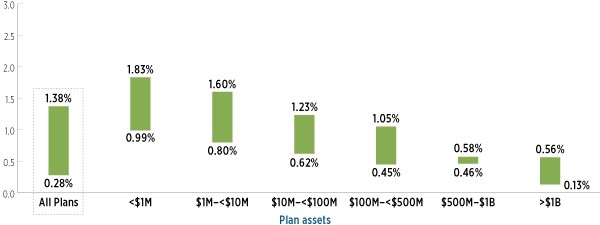News Release
Retirement Plan Fees Driven by Many Factors: Deloitte/ICI Study
Drivers Include Plan Size, Asset Allocation, Contribution Rates, and Auto Enrollment
Washington, DC, November 15, 2011 - A comprehensive study of the factors that appear to drive fees in 401(k) and other defined contribution retirement plans, released today by Deloitte and the Investment Company Institute, found that fees are closely related to a number of factors, including:
- the size of the plan (number of participants and average participant account balance);
- allocation of plan assets to equities;
- number of investment options;
- participant contribution rates; and
- use of automatic enrollment.
The study, Inside the Structure of Defined Contribution/401(k) Plan Fees, which updates and expands a 2009 survey, looks at total fees charged across a broad sample of 525 defined contribution plans with a range of plan sizes, service levels, investment offerings, retirement service providers, and fee structures. More than 250 data points on average were gathered from each of the plans studied. For each plan, Deloitte researchers calculated an “all-in fee,” a comprehensive measure of administrative, recordkeeping and investment-related fees, whether paid by the plan sponsor, the participant or the plan, as a percentage of plan assets.
A key finding of the study shows that, for the companies surveyed, the number of participants and the average participant account balance in the plan are primary drivers of a plan’s all-in fee. Specifically, plans with more participants and higher average account balances typically had lower all-in fees, benefitting from economies of scale by spreading fixed administrative costs over more assets and participants.
The allocation of plan assets to equity investment options is also cited as a primary driver of plan fees in the analysis. Plans with higher allocations to equity investment options tended to have higher all-in fees as a percentage of plan assets, consistent with the fact that equity investment options generally have higher expenses than other types of investments.
Three other factors also were found to be significant in explaining variation in defined contribution plan all-in fees. Plans with more investment options tended to have higher all-in fees than plans with fewer. On the other hand, plans with higher participant contribution rates or automatic enrollment tended to have lower all-in fees.
“This study serves a valuable purpose by separating the factors that drive fees from a number of other plan features that do not appear to have a significant impact on fees for the companies studied,” explained Daniel Rosshirt, a principal with Deloitte Consulting LLP, who led the research effort. “It’s notable that a number of factors that might be associated with complexity in servicing plans did not appear to have a significant effect on fees.”
These variables include the number of payrolls and number of business locations that a plan sponsor has. The study also examined, but found little fee impact resulting from the type of service provider (whether a mutual fund sponsor, life insurance company, bank, or third party administrator) or variables relating to the plan’s relationship with the service provider (such as tenure with the service provider, years since the last competitive review, or the percentage of assets invested in proprietary investments of the service provider).
“Defined contribution plans, including 401(k)s, represent about one-quarter of Americans’ retirement assets and play an important role in Americans’ saving for retirement,” said ICI President and CEO Paul Schott Stevens. “As regulatory changes and increased scrutiny on fees affect these plans, this study provides both a framework for analysis as well as an understanding of the factors driving fees for a cross section of plans.”
While any individual participant’s experience depends on the defined contribution plan offered by his or her employer, the median defined contribution plan participant is in a plan with an all-in fee of 0.78 percent of assets, based on plans included in the study. Across all participants, the all-in fee ranged from 0.28 percent of assets (the 10th percentile participant) to 1.38 percent of assets (the 90th percentile participant). Larger plans tended to have lower all-in fees.
All-In Fee Range—10th and 90th Percentile of Participants by Plan Asset Size Segment (Participant Weighted)
Percent of assets

Source: Deloitte/ICI Defined Contribution/401(k) Plan Fee Survey
“Commitment by employees and employers to saving for retirement appears to help drive fees lower,” said Sarah Holden, ICI’s senior director, retirement and investor research. “The study found that the plans tend to have lower all-in fees when the participants’ contribution rates are higher or the plan has automatic enrollment, which increases participation and also may increase participants’ contributions over time.”
While the survey was not intended to provide a statistical representation of the defined contribution plan market, the survey respondents represent a wide cross section of plans. The 525 plans surveyed from January through August 2011 ranged from less than $1 million in assets (56 percent of plans in the sample) to more than $1 billion in assets (7 percent of plans in the sample), and from fewer than 100 participants (64 percent of plans in the sample) to more than 10,000 participants (8 percent of plans in the sample).
To better represent the universe of 401(k) plans, survey responses were weighted to Department of Labor data based on plan assets and number of plan participants. While 87 percent of plans in the universe are small (have fewer than 100 participants), 86 percent of participants are in larger plans (100 or more participants). To focus on the fee experience of workers in 401(k) plans, all-in fee results in the report typically are calculated on a participant-weighted basis.
